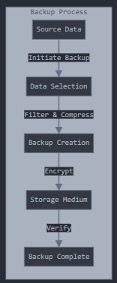Having a robust backup and restore strategy is crucial for business continuity and data protection. Let’s dive deep into understanding these essential processes and how they work together to safeguard your valuable information.
The Backup Process
The backup process is your first line of defense against data loss. Here’s a detailed breakdown of each stage:
Data Selection
The process begins with identifying critical data that needs to be backed up. This includes:
- Database files
- Configuration settings
- User documents
- System state information
Data Processing
Before storage, the selected data goes through several important steps:
- Compression to reduce storage space
- Deduplication to eliminate redundant data
- Encryption to ensure security
- Integrity checks to verify data consistency
Storage
The processed data is then transferred to the chosen storage medium. Common storage options include:
- Cloud storage solutions
- Network-attached storage (NAS)
- Tape drives
- External hard drives
The Restore Process
The restore process is equally important and must be well-planned to ensure successful data recovery when needed.
Backup Media Validation
Before beginning the restore process, the system:
- Verifies backup media integrity
- Checks for any corruption
- Validates backup checksums
Data Recovery
The actual restore process involves:
- Decrypting the backed-up data
- Decompressing files
- Rebuilding data structures
- Verifying data consistency
System Verification
After restoration, it’s crucial to:
- Validate all restored data
- Check system functionality
- Verify application compatibility
- Test data accessibility
Best Practices
To ensure effective backup and restore processes:
- Implement regular backup schedules
- Use multiple backup locations
- Test backups regularly
- Document backup procedures
For Backup:
- Maintain detailed restore procedures
- Regular restore testing
- Track restore performance metrics
- Document any issues encountered
For Restore:
Monitoring and Maintenance
Ongoing supervision of both processes should include:
- Regular audits of backup success rates
- Monitoring storage capacity
- Checking backup integrity
- Updating procedures as needed
Last Word
Understanding and implementing proper backup and restore processes is essential for any organization. The diagram above illustrates the flow of these processes, showing how each step connects to create a comprehensive data protection strategy. Remember that these processes should be regularly reviewed and updated to maintain their effectiveness and adapt to changing business needs.
By following these guidelines and maintaining proper documentation, organizations can ensure their data remains protected and recoverable when needed. Regular testing and updates to these processes will help maintain their reliability and effectiveness over time.







